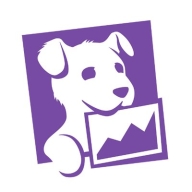

Datadog and PagerDuty compete in the field of application performance monitoring and incident management. While Datadog is recognized for its comprehensive monitoring capabilities, PagerDuty focuses more on alert handling and escalation functionalities, which gives it an upper hand in incident management efficiency.
Features: Datadog provides sharable dashboards, extensive integrations, and powerful visualizations that support capacity planning and root cause analysis. Its ease of use is praised, with intuitive tagging and flexibility in monitoring cloud applications. PagerDuty excels in incident management features including automated escalation policies and customizable notification options. It is effective for alert management and on-call scheduling, offering seamless alert handling and escalation functionalities.
Room for Improvement: Datadog could enhance user interface customization, develop a more intuitive query language, and improve documentation for complex features. Users desire better pricing transparency and additional functionalities for application performance monitoring and logging. PagerDuty could improve its analytics capabilities and noise suppression in alerting. Better integration with tools for a smoother workflow and handling multi-condition incident management are areas for development.
Ease of Deployment and Customer Service: Datadog supports deployment across private, public, and hybrid cloud environments, along with on-premises options, providing flexibility. It generally offers responsive customer support, though experiences vary. PagerDuty offers deployment across similar environments and is noted for excellent customer service with quick response times and high-quality support. While both provide strong support, PagerDuty's customer service is particularly praised for efficiency.
Pricing and ROI: Datadog's complex pricing is seen as worthwhile due to its features, though some find it expensive and hard to predict. It offers ROI through time savings and reduced downtime. PagerDuty is regarded as more affordable with straightforward pricing models. It can be costly at scale but provides value through efficient incident response. Both platforms offer good returns, with Datadog appealing to those who need comprehensive monitoring and PagerDuty focusing on incident management efficiency.
Previously we had thirteen contractors doing the monitoring for us, which is now reduced to only five.
Datadog has delivered more than its value through reduced downtime, faster recovery, and infrastructure optimization.
I believe features that would provide a lot of time savings, just enabling you to really narrow down and filter the type of frustration or user interaction that you're looking for.
The escalation was not possible at all before, which led to the L1 team being under too much stress.
The automated system efficiently monitors the infrastructure and notifies us about problems, benefiting both our customers and the bank's reputation.
Time to respond, time to initiate, and time to mitigate are key metrics influenced positively.
When I have additional questions, the ticket is updated with actual recommendations or suggestions pointing me in the correct direction.
Overall, the entire Datadog comprehensive experience of support, onboarding, getting everything in there, and having a good line of feedback has been exceptional.
I've had a couple instances where I reached out to Datadog's support team, and they have been really super helpful and very kind, even reaching back out after resolving my issues to check if everything's going well.
we have never had an issue when reaching out to someone in customer service
They understand our concerns and are willing to implement solutions that integrate into PagerDuty Operations Cloud effectively.
I have not needed to contact the customer support of PagerDuty Operations Cloud, as they provided thorough knowledge transfer once they handed over the services.
Datadog's scalability has been great as it has been able to grow with our needs.
We did, as a trial, engage the AWS integration, and immediately it found all of our AWS resources and presented them to us.
Datadog's scalability is strong; we've continued to significantly grow our software, and there are processes in place to ensure that as new servers, realms, and environments are introduced, we're able to include them all in Datadog without noticing any performance issues.
The product was highly scalable, with no limits on the number of applications or event routing rules.
The scalability of PagerDuty Operations Cloud is very good, and it can handle increasing traffic as our organization expands without any issues.
PagerDuty Operations Cloud is scalable; we can easily add teams, manage tags, and create teams.
Datadog is very stable, as there hasn't been any downtime or issues since I've been here, and it's always on time.
Datadog seems stable in my experience without any downtime or reliability issues.
Datadog seems to be more stable, and I really want to have a complete demo before making a call to decide on this.
We have never experienced any downtime or latency issues from PagerDuty Operations Cloud.
PagerDuty Operations Cloud is definitely stable, providing faster incident management and making managing our on-call roster easy along with effective escalation and notification channels.
It would be great to see stronger AI-driven anomaly detection and predictive analytics to help identify potential issues before they impact performance.
We want to be able to customize the cost part, and we would appreciate more granular access control.
The documentation is adequate, but team members coming into a project could benefit from more guided, interactive tutorials, ideally leveraging real-world data.
It would be useful to have a way to define all configurations in code that is similar to how Terraform operates.
With many new members, they need training to set up runbook workflows, event orchestration, and manage complex on-call schedules across 23 services, making it a challenge for new users.
Once a user acknowledges the alert, it may be unnecessary to continue calling again and again, as it distracts from their work on resolving the issue.
The setup cost for Datadog is more than $100.
Everybody wants the agent installed, but we only have so many dollars to spread across, so it's been difficult for me to prioritize who will benefit from Datadog at this time.
My experience with pricing, setup cost, and licensing is that it is really expensive.
I had around seven users part of it for a base pricing of around $450 per user, primarily for custom workflows and the ITSM part.
We have been using PagerDuty Operations Cloud for several years, so our pricing and cost have definitely increased over time, especially as we have hired additional engineers.
Pricing, setup cost, and licensing were not my headaches, and the organization already provided me with everything set up.
Our architecture is written in several languages, and one area where Datadog particularly shines is in providing first-class support for a multitude of programming languages.
Having all that associated analytics helps me in troubleshooting by not having to bounce around to other tools, which saves me a lot of time.
Datadog was able to find the alerts and trigger to notify our team in a very prompt manner before it got worse, allowing us to promptly adjust and remediate the situation in time.
It integrates with multiple applications and is highly customizable, with policies, escalation procedures, and an event routing tool that ensures contacting the right person.
In addition to those features, I also find the integration and reporting aspects of PagerDuty Operations Cloud valuable, as it records all triggered calls and incidents, enabling us to analyze patterns and identify the times when systems go down, thus assisting us in understanding and addressing the underlying causes.
Before, setting up everything was very difficult. Now, we don't have to think about it. We can simply set it up in PagerDuty and it works.
| Product | Market Share (%) |
|---|---|
| Datadog | 14.9% |
| PagerDuty Operations Cloud | 2.1% |
| Other | 83.0% |

| Company Size | Count |
|---|---|
| Small Business | 80 |
| Midsize Enterprise | 46 |
| Large Enterprise | 98 |
| Company Size | Count |
|---|---|
| Small Business | 15 |
| Midsize Enterprise | 14 |
| Large Enterprise | 26 |
Datadog integrates extensive monitoring solutions with features like customizable dashboards and real-time alerting, supporting efficient system management. Its seamless integration capabilities with tools like AWS and Slack make it a critical part of cloud infrastructure monitoring.
Datadog offers centralized logging and monitoring, making troubleshooting fast and efficient. It facilitates performance tracking in cloud environments such as AWS and Azure, utilizing tools like EC2 and APM for service management. Custom metrics and alerts improve the ability to respond to issues swiftly, while real-time tools enhance system responsiveness. However, users express the need for improved query performance, a more intuitive UI, and increased integration capabilities. Concerns about the pricing model's complexity have led to calls for greater transparency and control, and additional advanced customization options are sought. Datadog's implementation requires attention to these aspects, with enhanced documentation and onboarding recommended to reduce the learning curve.
What are Datadog's Key Features?In industries like finance and technology, Datadog is implemented for its monitoring capabilities across cloud architectures. Its ability to aggregate logs and provide a unified view enhances reliability in environments demanding high performance. By leveraging real-time insights and integration with platforms like AWS and Azure, organizations in these sectors efficiently manage their cloud infrastructures, ensuring optimal performance and proactive issue resolution.
The PagerDuty Operations Cloud is the platform for mission-critical, time-critical operations work in the modern enterprise. Through the power of AI and automation, it detects and diagnoses disruptive events, mobilizes the right team members to respond, and streamlines infrastructure and workflows across your digital operations. The Operations Cloud is essential infrastructure for revolutionizing digital operations to compete and win as a modern digital business.
PagerDuty Features
PagerDuty has many valuable key features. Some of the most useful ones include:
PagerDuty Benefits
There are many benefits to implementing PagerDuty. Some of the biggest advantages the solution offers include:
Reviews from Real Users
Below are some reviews and helpful feedback written by PeerSpot users currently using the PagerDuty solution.
Brandon J., Director of engineering at a wellness & fitness company, says, "The SMS pages and the mobile application are pretty much the top two features."
PeerSpot reviewer Pramodh M., DevSecOps Consultant at a tech services company, comments, “The inbound integrations that PagerDuty provides with most of the DevOps tools are valuable. There is a flexible and easy way of integrating with monitoring tools. It allows us to configure the integration with APIs and plugins as well.”
Syed Mohammad A., Vice President - Operations and Client Services at a financial services firm, mentions, "PagerDuty let us set up rosters based on our shifts. We could assign a hierarchy for how the calls should be escalated and the number of times the call will be transferred between people before it is answered. It makes it easy to access an agent via mobile phone."
A Principal Architect at an energy/utilities company states, “The most important feature that is used is call scheduling. We are also able to actually call IT folks in the case of an emergency.”
We monitor all AIOps reviews to prevent fraudulent reviews and keep review quality high. We do not post reviews by company employees or direct competitors. We validate each review for authenticity via cross-reference with LinkedIn, and personal follow-up with the reviewer when necessary.